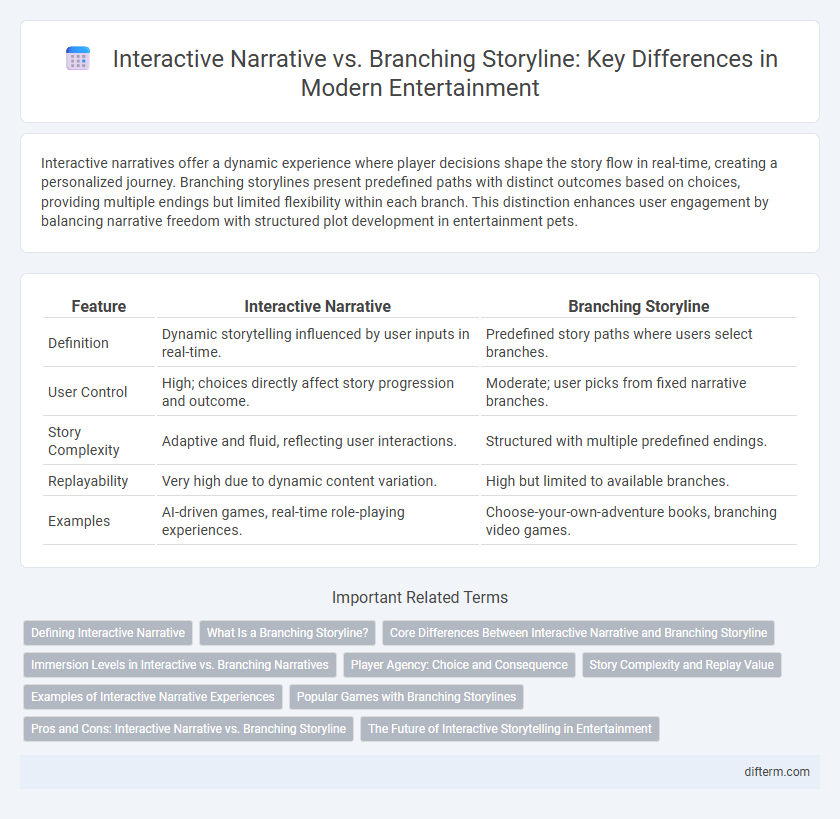Interactive narratives offer a dynamic experience where player decisions shape the story flow in real-time, creating a personalized journey. Branching storylines present predefined paths with distinct outcomes based on choices, providing multiple endings but limited flexibility within each branch. This distinction enhances user engagement by balancing narrative freedom with structured plot development in entertainment pets.
Table of Comparison
| Feature | Interactive Narrative | Branching Storyline |
|---|---|---|
| Definition | Dynamic storytelling influenced by user inputs in real-time. | Predefined story paths where users select branches. |
| User Control | High; choices directly affect story progression and outcome. | Moderate; user picks from fixed narrative branches. |
| Story Complexity | Adaptive and fluid, reflecting user interactions. | Structured with multiple predefined endings. |
| Replayability | Very high due to dynamic content variation. | High but limited to available branches. |
| Examples | AI-driven games, real-time role-playing experiences. | Choose-your-own-adventure books, branching video games. |
Defining Interactive Narrative
Interactive narrative is a storytelling technique where the audience actively participates in shaping the story through choices and actions, creating a dynamic and immersive experience. Unlike branching storylines that offer predefined paths and outcomes, interactive narratives emphasize player agency and emergent story developments driven by interactions. This approach enhances engagement by allowing personalized narrative journeys that evolve based on user input and behavior.
What Is a Branching Storyline?
A branching storyline is a narrative structure used in interactive entertainment where the plot diverges at key decision points, leading to multiple possible endings or paths. Each choice made by the player influences the direction of the story, creating a personalized experience and enhancing replayability. This method contrasts with linear storytelling by offering complex, variable outcomes shaped by user interaction.
Core Differences Between Interactive Narrative and Branching Storyline
Interactive narrative centers on player-driven storytelling where choices influence character development and world dynamics, creating a fluid experience shaped by user interaction. Branching storyline relies on predefined plot paths with multiple decision points, offering distinct alternative endings but limited adaptive depth. The core difference lies in interactivity scope: interactive narratives emphasize emergent storytelling shaped by player actions, while branching storylines focus on divergent, scripted plot branches.
Immersion Levels in Interactive vs. Branching Narratives
Interactive narratives enhance immersion by allowing players to influence the story dynamically, creating a personalized experience that adapts to their choices in real-time. Branching storylines offer predefined pathways, giving a sense of agency but limiting immersion through fixed plot outcomes. The fluidity of interactive storytelling typically results in deeper emotional engagement compared to the segmented, choice-driven structure of branching narratives.
Player Agency: Choice and Consequence
Interactive narratives empower player agency by allowing choices that shape the story's emotional and thematic depth, creating a personalized experience. Branching storylines provide distinct narrative paths based on player decisions, emphasizing consequence and replayability. Both frameworks enhance engagement but differ in complexity and impact on story coherence.
Story Complexity and Replay Value
Interactive narratives offer dynamic story complexity by adapting to player choices in real-time, creating a fluid and immersive experience. Branching storylines provide predefined paths that expand replay value through multiple distinct endings and scenarios. Both methods enhance engagement, but interactive narratives tend to deliver deeper personalization while branching storylines emphasize varied story outcomes.
Examples of Interactive Narrative Experiences
Interactive narrative experiences such as "Detroit: Become Human" immerse players by adapting the story based on nuanced choices, allowing characters' personalities and relationships to evolve dynamically. Unlike traditional branching storylines seen in games like "The Witcher 3," where paths split into predefined outcomes, interactive narratives create a fluid storytelling environment that responds to player decisions in real-time. Games like "Life is Strange" and "Her Story" exemplify this approach by blending player agency with evolving plotlines that reflect emotional and psychological depth.
Popular Games with Branching Storylines
Popular games with branching storylines such as The Witcher 3, Mass Effect, and Detroit: Become Human emphasize player choice and consequence, allowing multiple narrative paths and endings. Unlike interactive narratives that often focus on real-time player input and immersion, branching storylines provide discrete decision points that shape the plot trajectory. These titles showcase the appeal of adaptive storytelling, enhancing replayability and personalized gaming experiences through a complex web of interconnected choices.
Pros and Cons: Interactive Narrative vs. Branching Storyline
Interactive narratives immerse players by adapting story elements based on choices, offering a cohesive experience but sometimes limiting player control due to predetermined story paths. Branching storylines provide multiple distinct endings and significant player agency, yet they can lead to fragmented storytelling and increased development complexity. Both approaches balance player engagement and narrative depth, with interactive narratives favoring fluid storytelling and branching storylines emphasizing diverse outcomes.
The Future of Interactive Storytelling in Entertainment
Interactive narrative in entertainment transforms passive viewers into active participants, fostering personalized experiences through dynamic story progression tailored by user choices. Branching storylines offer multiple predefined paths but can limit narrative depth compared to adaptive interactive narratives powered by AI-driven content generation. The future of interactive storytelling hinges on seamless integration of machine learning and real-time decision-making, enabling immersive, emotionally rich experiences that evolve uniquely with each user interaction.
interactive narrative vs branching storyline Infographic

 difterm.com
difterm.com